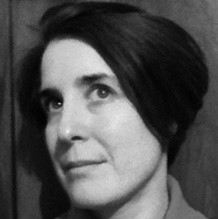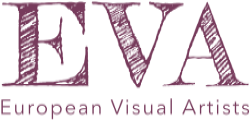Kate Mayne addressing the Members of the European Parliament about the realities of artists’ lives, in the context of the vote on Copyright Reform and the importance of fair remuneration for artists.
Some words on the practical realities of artists
Dear members of the European Parliament,
On June 5th EVA, or European Visual Artists, invited me to paint, and to speak, at the
European Parliament. I am grateful to have been given this opportunity to tell you a bit
about how artists work. I have written down what I said that day, with a few additions.
It’s a long way from the artist’s studio to the European Parliament. It is significant to
stand here amongst the pristine carpets and spotless table cloths in my painting clothes.
Paint on my hands. Under my fingernails. A little absurd, perhaps, but natural, because we
are doing our thing and when you can do that, under the right conditions, you can be truly
present. That is when your heart opens up and everywhere feels like home.
Art is a vocation. Many artists would not do that well in other occupations, there is
some truth to that. But, contrary to what clichés and myths of individualism or the solitary
genius would have us think, art, and everything it entails, is a communal activity. Artists
don’t function in isolation. We’re social animals. We care about being seen and heard,
under the right conditions. Any work of art that is worth its salt is like a magic mirror: it has
an uncanny knack, to humans, of revealing ourselves to ourselves, and to each other. At
times it is uncomfortable, at others, it brings illumination.
Art is a form of communication. It is a touchstone, that touches us in ways
words do not. It has a gentler thrill than figures in an annual report. It is not linear. It goes
all over the place and can hit you below the belt when you least expect it. It follows its own
logic, shimmies past those market concerns that seem to be ruling our societies today
(please let there still be something else. Humanism?); it has ways of getting under your skin,
blowing us away and reorienting us towards new ways of being. It is difficult to say how it
does this. You can’t dissect a work of art to discover what makes it – or, actually, you –
tick. Art is mysterious. We don’t understand its brilliance, but we appreciate it, and we are
buoyed by it, as a species.
Marcel Duchamp was of the opinion that art resides in the space between the
conception of a work of art, and its execution. He called this infrathin. I dare to venture it
resides also in the gap between object and reception. Art crackles in a space beneath words,
and as such, it is a hugely valuable interface: a starting point for communication.
What do artists need to make their work? Time and space. You need time, and an
attention span that lasts long enough for sustained work; you need to be able to research
and develop an idea, a form, there needs to be time for mistakes, and trial and error. It isn’t
true to market principles, it is true only to itself. With luck it gets sold. Or not. Does that
make it any less valuable? When you start a piece of work, you can never be sure where
you’ll end up. There is no guarantee, and no standard way to gauge the value of a work of
art, although its tangible benefits to society have been widely researched and documented.
In Delacroix’s Studio in Saint-Germain-des-Près there is a portrait I found most
touching, of his housekeeper. The label told me he used Mars Yellow for the skin-tone.
These are secrets of the trade. If you don’t have access to a lab, you have to guess them by
eye, and try to discover the recipe by mixing, through trial and error. But what struck me
most was that this woman, who lived at Delacroix’ side for over twenty years, would
answer the door and keep sending his friends and admirers away. Delacroix was a key
figure in cultural Paris in the late 19th century, so everyone wanted to see him. The
housekeeper, whom Delacroix cared about enough to paint, would send them all away, so
he could get on with his painting. She dedicated her life to making his work possible.
I
know many artists who rely on the support of their boyfriend, wife, family, friends,
gallerists, curators… to help them create the circumstances in which their work happens –
with financial, practical and emotional support, or space. This is no luxury. Every bit of
help is significant.
Artists also need space, which is increasingly harder to come by these days.
Property prices are on the rise, as is the cost of living, so you need considerable means to
get your work done. I would like to tell you about another place I visited, the Camille
Claudel Museum, in Nogent-sur-Seine, 1:15 by train from Paris. They renovated the town’s
brasserie too, where you can sip a glass of rosé on a summer afternoon and swoon in the
scent of flowers by the river.
The new museum is well curated, showing the context in which the teenage Camille
Claudel emerged as a young artist. Despite limited opportunities for women artists at the
time, her talents were recognized, and she did get a fair bit of support. How the dynamics
worked in her relationship with Rodin is a separate discussion, but I would like to mention
one point in the museum which shocked me. We see her work develop alongside that of her
male contemporaries, with large marble sculptures, as befits the time. One moment she is
making monumental works of marble, and the next, her work becomes tiny and diminutive.
I don’t wish to suggest large is better than small, but here I sensed a loss of majesty. The
reason the work became small was not artistic. The label said she had broken up with
Rodin just before. It is easy to deduce the work changed so dramatically, because Camille
Claudel no longer had access to a studio.
I would also like to tell you about Edouard Glissant, the poet-philosopher
from Martinique who spent most of his life in Paris. The Brussels artist Marc
Rossignol – whose work absorbs multiple cultures in the most compelling ways – told me
about him. Glissant’s ‘Philosophie de la Relation’ is a plea to view culture as a ‘tout monde’ of
differences, that should not be conformed to one universal ideal, but instead be appreciated
for their unicity. He suggested true creativity occurs in the spaces between these
differences, when you go out to meet them, in a perpetual state of growth and learning. It
was his view that traumas can heal in the invention that occurs when you consciously set
out to meet otherness in a state of vulnerability. The European Union was founded on
the traumas of the second world war. Now, in 2018 the air is still thick with trauma. How
much have we resolved of our parent’s pain? What about our own subconscious ones?
There is at present a huge crisis in the European Union.
At times like these, artists should be brought to the centre of the European
project. They are experts at dealing with uncertainty, creativity, invention, communication,
and change. Art can help to heal trauma.
I would like to tell you how the Royal Athenaeum
in Antwerp, an inner-city school with countless nationalities, led by the principal and deradicalization
expert Karin Heremans, responded not so long ago, to the very real crisis of
some students being seduced to fight in Syria. They school invited artists to come and work with
the pupils. This project, called Athena-Syntax, was initiated by the science teacher, Rudi
Audiens, with the school’s Islam teacher, Mohamed Filali. They invited the young sculptor
Timothy Segers to give a workshop: he had the pupils make a giant ball by sticking ultrathin
cellophane sheets of paper together with tape. They inflated it and rolled the giant
thing throughout the school. As a group. Every time a hole occurred, and the air started to
escape, they had to stick it shut again with tape. Thanks to the Athena-Syntax program of
arts in the school, combined with a sustained, proactive approach across all subjects, no
further students were lost to Syria.
It is important to stress that very few artists get to live from the sale of their works
alone. This does not mean that those who may be teaching the next generation of artists,
who will create the objects in which we will temporarily find or lose ourselves, or question
who we are about to become, are any less successful as artists. In a sector as unpredictable
as ours, success can be down to a fluke balance of variables, in addition to mere talent and
the proverbial perspiration.
So please understand that we will continue to defend what rights of remuneration
we do have. It may not pay the rent, but it might help finance a new camera, or part of a
young sculptor’s studio costs, or a quiet place where they will not be disturbed so they can
work, and make something, before they go out and meet their peers and show their work to
the public. Please support us in this. And please keep watching and engaging with us.
Because I have a feeling you love art as much as we do.
I would like to finish with a quote from Marguerite Yourcenar’s ‘Oeuvre au Noir’, whose
words are chiselled in stone in a park in the centre of Brussels, and also on her tiny
tombstone:
“Plaise à Celui qui est peut-être de dilater le coeur de l’homme à la mesure
de toute la vie.”
“May it please the One who perchance is to expand the human heart to
life’s full measure.”
It occurs to me that creating the circumstances for these spaces to open up is something
that is up to us all.
Thank you kindly for your attention.
Kate Christina Mayne
Antwerp, June 2018

© the artist
Kate Mayne is an artist and writer. She manages the artistic projects, prizes and bursaries for SOFAM, an authors’ rights organization for visual artists in Belgium, on a freelance basis.

